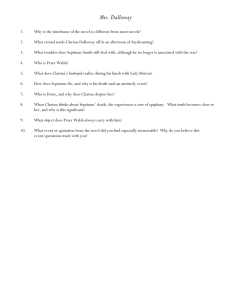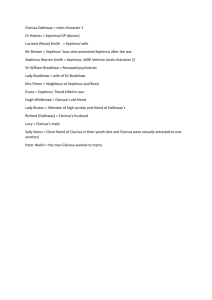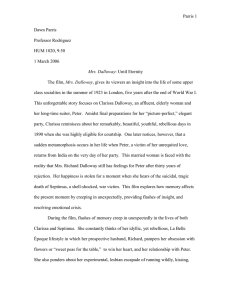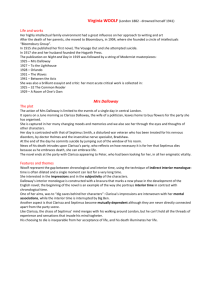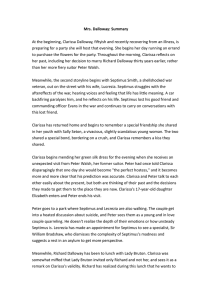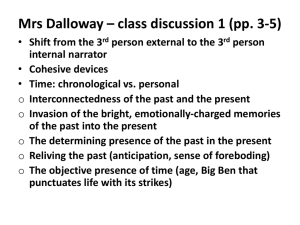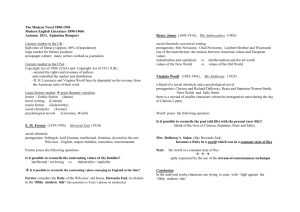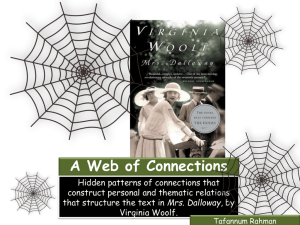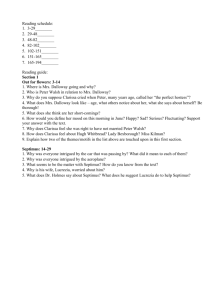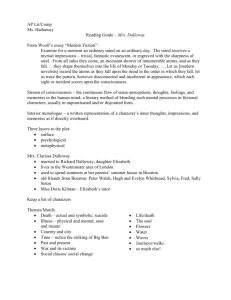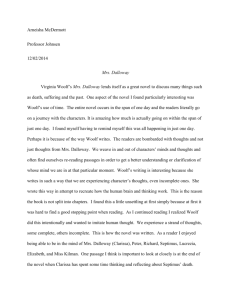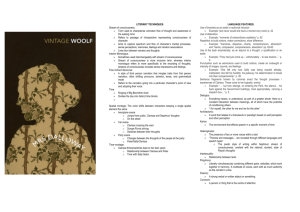Lecture notes on Mrs. Dalloway
advertisement
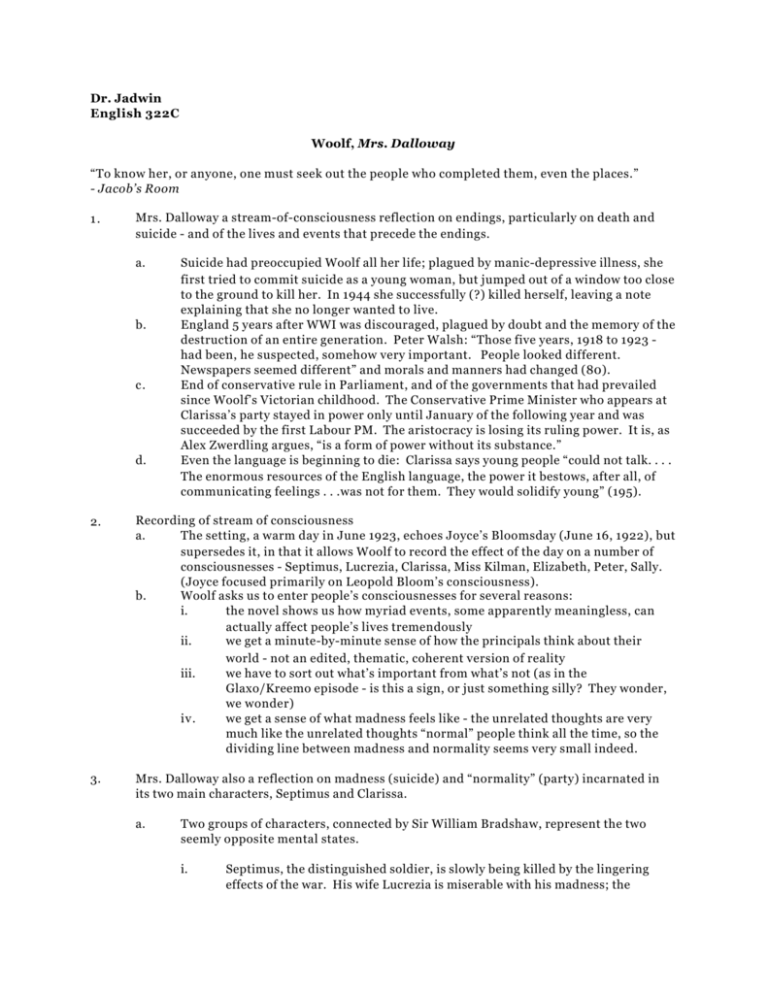
Dr. Jadwin English 322C Woolf, Mrs. Dalloway “To know her, or anyone, one must seek out the people who completed them, even the places.” - Jacob’s Room 1. Mrs. Dalloway a stream-of-consciousness reflection on endings, particularly on death and suicide - and of the lives and events that precede the endings. a. b. c. d. Suicide had preoccupied Woolf all her life; plagued by manic-depressive illness, she first tried to commit suicide as a young woman, but jumped out of a window too close to the ground to kill her. In 1944 she successfully (?) killed herself, leaving a note explaining that she no longer wanted to live. England 5 years after WWI was discouraged, plagued by doubt and the memory of the destruction of an entire generation. Peter Walsh: “Those five years, 1918 to 1923 had been, he suspected, somehow very important. People looked different. Newspapers seemed different” and morals and manners had changed (80). End of conservative rule in Parliament, and of the governments that had prevailed since Woolf’s Victorian childhood. The Conservative Prime Minister who appears at Clarissa’s party stayed in power only until January of the following year and was succeeded by the first Labour PM. The aristocracy is losing its ruling power. It is, as Alex Zwerdling argues, “is a form of power without its substance.” Even the language is beginning to die: Clarissa says young people “could not talk. . . . The enormous resources of the English language, the power it bestows, after all, of communicating feelings . . .was not for them. They would solidify young” (195). 2. Recording of stream of consciousness a. The setting, a warm day in June 1923, echoes Joyce’s Bloomsday (June 16, 1922), but supersedes it, in that it allows Woolf to record the effect of the day on a number of consciousnesses - Septimus, Lucrezia, Clarissa, Miss Kilman, Elizabeth, Peter, Sally. (Joyce focused primarily on Leopold Bloom’s consciousness). b. Woolf asks us to enter people’s consciousnesses for several reasons: i. the novel shows us how myriad events, some apparently meaningless, can actually affect people’s lives tremendously ii. we get a minute-by-minute sense of how the principals think about their world - not an edited, thematic, coherent version of reality iii. we have to sort out what’s important from what’s not (as in the Glaxo/Kreemo episode - is this a sign, or just something silly? They wonder, we wonder) iv. we get a sense of what madness feels like - the unrelated thoughts are very much like the unrelated thoughts “normal” people think all the time, so the dividing line between madness and normality seems very small indeed. 3. Mrs. Dalloway also a reflection on madness (suicide) and “normality” (party) incarnated in its two main characters, Septimus and Clarissa. a. Two groups of characters, connected by Sir William Bradshaw, represent the two seemly opposite mental states. i. Septimus, the distinguished soldier, is slowly being killed by the lingering effects of the war. His wife Lucrezia is miserable with his madness; the doctors are unhelpful (Holmes, then Bradshaw) and they have few friends in England except the acquaintances that appear in the book (their landlady, a few neighbors, etc.) (1) (2) (3) (4) ii. Clarissa, the rich housewife (her husband Richard is a moderately successful MP), has many friends; their daughter Elizabeth, Miss Kilman her teacher, Lady Bruton, who invites Richard to lunch without Clarissa; Peter Walsh, and Sally Seton/Lady Rosseter. (1) (2) (3) iii. 4. Septimus’s primary obsession is death; Lucrezia, though she won’t say it aloud, also wants him to die because she is so unhappy. Septimus’s insistent memories of the war and the total loss of feeling he sustained because of it show us how the war, though over, is still stealing lives. Septimus realizes that, unable to feel, he must not continue to live. The war “taught him not to care” when his superior officer, Evans, was killed. Later Septimus married Lucrezia to try to get back feeling, but it hasn’t worked. He knows he must die; the question is how to do it. Septimus, as a “winner” and “survivor” of the war, enjoys none of its benefits. Clarissa is also thinking about death, but focusing on her party and its implications as she thinks forward and backward about the gathering of people she will assemble in the evening. Peter and Sally, Clarissa’s two old friends, bring a “class reunion” feel to the party, where all the major players are rethinking the choices they’ve made, many of which seem like mistakes. Clarissa, as a privileged, wealthy woman, enjoys none of the personal security and satisfaction that her social position appears to bestow. Sir William Bradshaw, the society physician, brings the news of Septimus’s suicide to the party, bridging the two groups and connecting one death with another social twilight - of the Dalloways’ social milieu. The metaphor of a spider’s web connects the novel’s events. a. The plot is very simple: Clarissa plans a party; Peter Walsh, her old suitor, returns to England after five years in India; Sally Seton, another old friend, shows up unexpectedly at the party; Septimus Warren Smith kills himself. The linking character in this “web” is Sir William Bradshaw, the Dalloways’ friend and Septimus’s doctor. The metaphorical “web” connects the unconnected (literally and figuratively) in a common circle of experience regardless of their class standings. b. When Richard leaves Lady Bruton’s after lunch, a “spider’s thread” woven between the lunchers stretches and breaks during Lady Bruton’s nap; Richard later drowses, thinking of Clarissa and reattaching himself to the web. He suddenly is seized with the desire to bring her flowers, to tell her he loves her (170-4) and later brings the flowers but doesn’t declare his love. The metaphor of the web suggests connection, but it is a home, a trap, a soft, flexible series of threads that can be broken; it is something the unwary fly into. When Clarissa learns of Septimus’s death, she notices that she feels “like him,” suggesting that madness is a species of normality and that the efforts of her life are in c. d. a way as insane as his. 5. The thing to be feared, whether as a consequence of the war or of prosperity, is the atrophy of the heart, repression of instinct and emotion that allows one to stay “sane” and “normal.” a. Emotionally intense characters like Peter Walsh and Doris Kilman, who find it hard to restrain their emotions, are in serious trouble. “She found it impossible to control the hot and turbulent feelings which boiled and surged in her” (137). They are outsiders in a society that is struggling to cover up the destruction of the war. Those who fail to restrain their emotions remain always on the outside of power. i. Kilman is dehumanized by her Germanness, her poverty, her incipient lesbianism, her rage. Like Septimus, she is on the margins of sanity. b. Others, like Peter and Sally, who capitulate, become part of the system itself. i. Peter was a rebel - expelled from Oxford, a socialist in his youth - but now has “done just respectably, filled the usual posts adequately” (170) and now has returned to England, fleeing revolution in India, to exploit his old school ties to find a civil-service job. ii. Sally once favored abolishing property; she “radiated a sort of abandonment, as if she could say anything, do anything” (37). But she marries an old bald man who owns factories, and raises “five enormous boys” as Lady Rosseter. c. The “sane” characters, emblematized by Sir William Bradshaw, see it as their job to make sure “these unsocial impulses. . .are held in control” (113). Sir William: made England prosper, secluded her lunatics, forbade childbirth, penalised despair, made it impossible for the unfit to propagate their views (110) d. The emotionless “normal” and “ruling” class must keep everyone else under control, created a colorless web that traps abnormality. Lady Bruton is described as floating on the grey tide of service which washed round her day in, day out, collecting, intercepting, enveloping her in a fine tissue which broke concussions, mitigated interruptions, and spread round the house in Brook Street a fine net where things lodged and were picked out accurately, instantly (199). e. 6. Even something as traumatic as a suicide has to be reduced to a category, to a prod for legislation. Sir William turns Septimus into a case to be transformed into a provision in a Bill. The novel’s ending scene draws together its main arguments, as Clarissa withdraws from the party to think about the death of a former soldier she has never met, but with whom she feels an affinity. a. The little room is a solitary retreat where “the party’s splendor fell to the floor so strange it was to come in alone in her finery” (202). b. She recognizes that he has courageously ended an unmeaning, unsatisfactory life: “A thing there was that mattered; a thing, wreathed about with chatter, defaced, obscured in her own life, let drop every day in corruption, lies, chatter. This he had preserved” (202). c. To be normal/sane/accepted, she has sacrificed her most important emotional relationships (with Peter, Sally) and distanced herself from people she loves (Elizabeth) through rigid condemnation/treating them as property (“This is my Elizabeth”). d. So what does the last paragraph of the novel point to? Woolf leaves that deliberately open; whether it is some group form of revelation, or Clarissa’s death, is open to interpretation.
